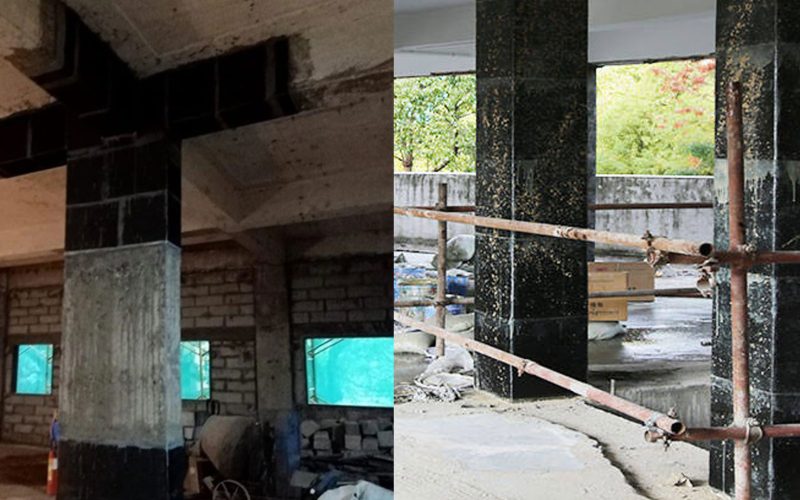In modern India, aging buildings frequently require structural attention as time progresses.
Growing urban populations and heavier usage strain old beam systems prematurely.
Therefore, engineers seek reliable methods to extend lifespan and usage while maintaining safety.
One proven method is Carbon Wrapping, which reinforces beams without major disruption.
This approach is ideal for homeowners, builders, and infrastructure teams in India.
Below, we explain process, benefits, applications, and guidelines for using this solution.
Why Beams Need Reinforcement in Indian Buildings
Many Indian structures now exceed original design lives due to rapid usage changes.
Beams deteriorate from corrosion, overload, seismic events, and moisture penetration over years.
Consequently, cracking, debonding, and sagging become visible structural problems.
Instead of demolition, reinforcement offers smart, economical choices.
Thus, Carbon Wrapping is emerging as a preferred structural repair solution.
It provides strength, resilience, and quicker construction without altering aesthetics or function.
The Science Behind Carbon Wrapping
This technique uses high‑tensile carbon fiber sheets bonded to beam surfaces.
Combined with specialized resin, it forms a robust composite strengthening external beam surfaces.
Due to exceptional strength‑to‑weight ratio, it reinforces without adding significant mass.
Furthermore, it resists corrosion, chemicals, and temperature changes typical in Indian climates.
Hence, Carbon Wrapping suits beams in coastal, industrial, and urban settings.
Its non‑intrusive nature ensures repair without major demolition or extended downtime.
Application Process: Step by Step
First, a structural assessment locates weak zones and calculates required strength gain.
Next, technicians clean and prepare the beam surface thoroughly, removing debris and rust.
Afterward, a bonding primer is applied to enhance adhesive performance.
Then, carbon fiber sheets are placed carefully and pressed with rollers.
Multiple layers may be added according to structural needs and engineering specs.
Finally, curing and protective coating complete the Carbon Wrapping process.
Advantages Over Traditional Techniques
Conventional methods like steel jacketing or concrete encasement are more intrusive.
They add bulk, increase load, and may require re‑designing adjacent elements.
Moreover, those methods take longer and often disrupt occupants.
By contrast, Carbon Wrapping is thin, fast, and space‑efficient.
It integrates seamlessly without infringing on usable space or altering building form.
Thus, it’s preferred by engineers and property owners seeking smart, efficient repairs.
Adaptability for Indian Seismic Zones
India includes several high‑risk seismic regions like Uttarakhand and Northeast India.
Older unsafe beams need reinforcement to prevent brittle fractures during tremors.
The flexibility of Carbon Wrapping enables beams to withstand seismic forces better.
This method improves ductility and energy dissipation without compromising structural geometry.
Even heritage buildings and residential blocks in quake‑prone areas are benefiting.
Therefore, this technique is recognized as a valuable seismic retrofitting solution.
Climate Resistance and Durability
Indian climates range from monsoon humidity to coastal salt spray exposure.
Steel reinforcements corrode over time, weakening concrete beams severely.
In contrast, Carbon Wrapping is completely immune to corrosion and chloride attack.
It maintains structural integrity under extreme weather conditions and temperature swings.
Thus, beams reinforced with this method enjoy long‑term performance with little maintenance.
This durability makes it a cost‑effective and reliable solution in Indian conditions.
Cost‑Effective Long‑Term Benefits
Although initial investment may seem higher, Carbon Wrapping pays long-term.
Reduced future maintenance, minimal occupancy disruption, and extended service life matter.
Furthermore, avoiding heavy demolition saves on labor and material costs.
Projects complete faster, helping businesses and homeowners resume normal operations.
In city centers like Mumbai and Bengaluru, downtime savings are especially valuable.
Therefore, this method offers a high return-on-investment over a building’s lifespan.
Real‑Life Applications in India
Many buildings across India already use this repair method successfully.
For example, parking garages in Pune and Mumbai have had beams reinforced.
In Chennai, older hospital wards now use it to avoid relocation during repairs.
Heritage schools in Kolkata also benefit from beam strengthening without altering historic facades.
Even commercial complexes in Delhi are being retrofitted using this approach.
These cases illustrate how Carbon Wrapping adapts to diverse structural and social needs.
Integration with Other Repair Techniques
Recovery projects often combine beam strengthening with crack injection or column retrofits.
For instance, epoxy injection seals cracks before setting fibers on beam soffits.
Also, columns can be retrofitted concurrently using similar fiber techniques.
This holistic approach ensures entire structural frames work together under load.
Thanks to this compatibility, Carbon Wrapping is favored in comprehensive rehabilitation plans.
It allows phased implementation without hampering ongoing building function.
Safety and Quality Assurance
Proper execution of Carbon Wrapping requires trained professionals and quality materials.
Contractors should follow international codes and verify material certifications.
Surface preparation, resin mixing, fiber placement, and curing all require accuracy.
Quality checks like pull‑off tests ensure bond strength post‑application.
Additionally, engineers must inspect periodically for delamination or wear.
Overall, rigorous adherence to standards guarantees safe, lasting beam reinforcement results.
Maintenance Needs and Longevity
Once correctly applied, this reinforcement needs minimal upkeep over decades.
Regular visual inspections suffice, with few cases requiring maintenance or touch‑ups.
Protective coatings on fiber further reduce abrasion, UV exposure, and grime buildup.
Thus, beams strengthened with this method remain reliable over 30 to 40 years.
That contrasts sharply with periodic steel repairs and recurrent resurfacing needs.
Consequently, Carbon Wrapping delivers dependable long‑term structural performance.
Dispelling Common Misconceptions
Some believe that carbon fiber solutions are only for exotic or high‑cost projects.
In reality, they are viable even for modest residential retrofits in Indian towns.
Others worry about complexity, but the process is swift and less invasive.
Furthermore, many think it needs complete evacuation of premises, which is untrue.
As awareness grows, Carbon Wrapping is recognized as efficient and accessible—not just elite.
Education and demonstrations are helping shift perception across stakeholder communities.
Choosing the Right Provider in India
Selecting a contractor with proven experience matters greatly for success.
Look for teams with structural engineering credentials and certified technicians.
Ask for past project portfolios, site audits, and test reports verifying results.
They should offer detailed proposals, timelines, and transparent quality assurance protocols.
A reliable provider will support post‑installation inspections and maintenance schedules.
With the right partner, Carbon Wrapping transforms structural repair into confidence and safety.
Future Trends and Innovations
As India urbanizes faster, mid‑life building upgrades will become more routine.
Material science is evolving; hybrid fibers and embedded sensors may improve coverage.
Non‑destructive evaluation via drones or imaging could monitor fiber‑bond health.
Moreover, integration with green building trends positions this method strongly.
Still, Carbon Wrapping will remain core to retrofit strategies for beams and slabs.
Its combination of strength, minimal disruption, and reliability makes it future‑proof.
A Smart Investment for Structural Safety
In conclusion, Carbon Wrapping offers a smart structural repair solution with lasting results.
It reinforces beams effectively while supporting ongoing occupancy and use.
In the Indian context, its benefits include corrosion resistance, seismic performance, and minimal disruption.
With proper application and quality checks, it gives decades of structural integrity.












